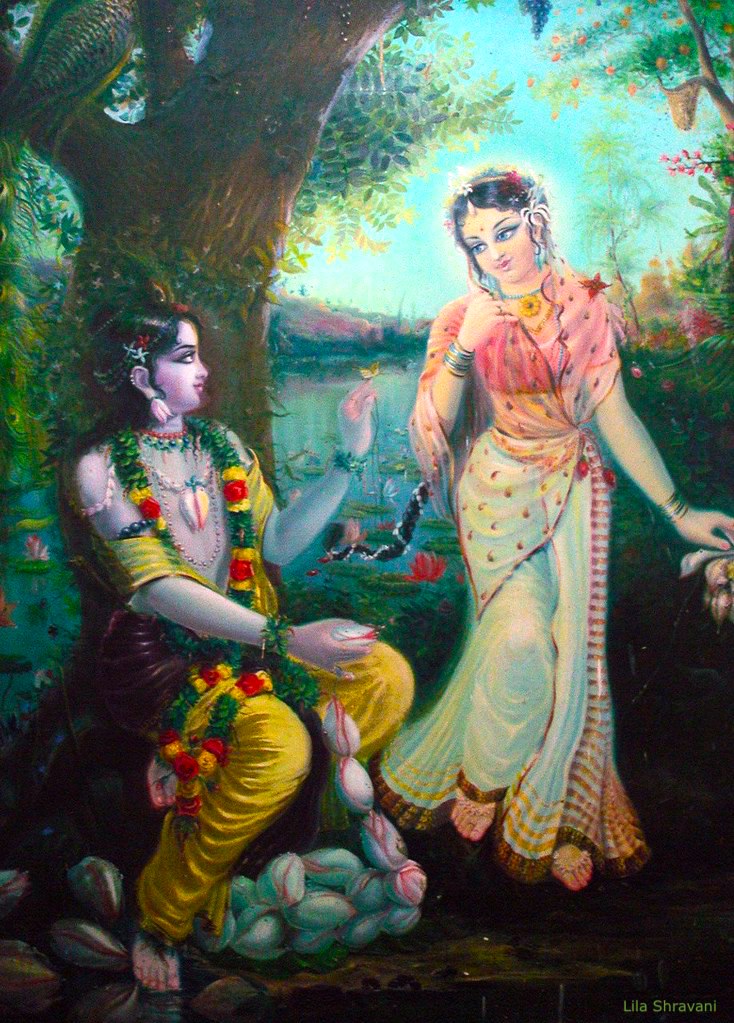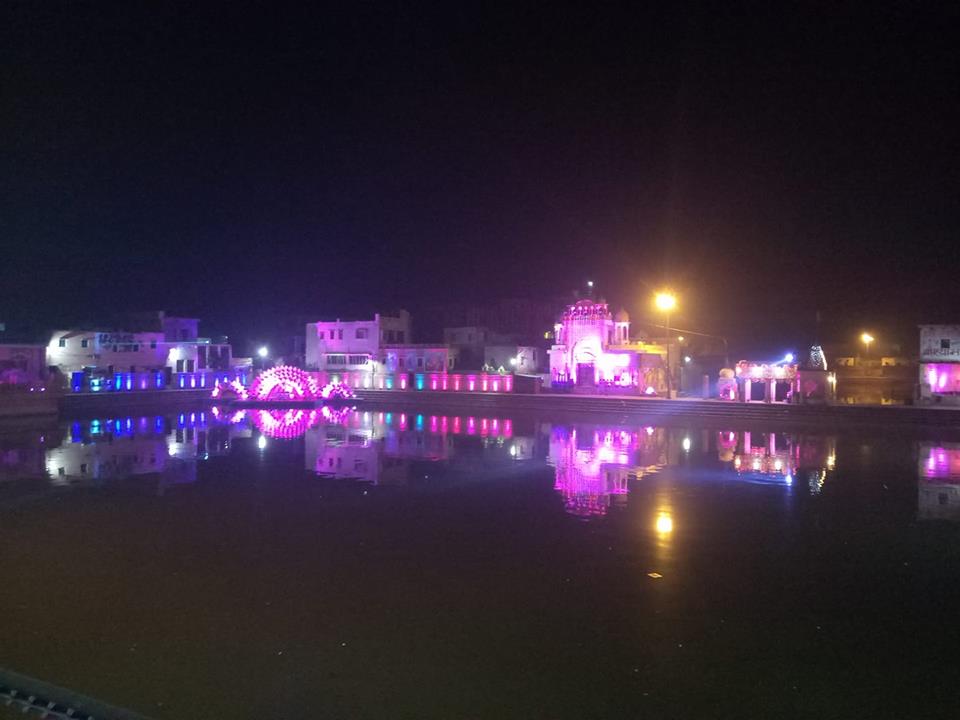Mahanidhi Swami
One night in Nidhuvana, Vrindavana, while sleeping beside Shyamasundara, Srimati Radharani saw an amazing dream. The contents of Sri Radha’s wonderful experience have been revealed by Srila Visvanatha Cakravartipada and other Gaudiya Vaisnava poets. Here we will share their visions and versions of Srimati’s ambrosial dream experience. So my dear friends, please read, relish, remember and realize as you feel the bliss arise in your eyes! Gaurangi Shyama ki jai ho!
Srila Visvanatha Cakravartipada:
First we will present his short work, “Svapna Vilasamritam”, Ambrosial Interlude in a Dream.
Startled and amazed, Radhika suddenly awoke and said, “O Priyatama! I just saw an incredible dream. I saw a river, very much like our Yamuna here in Vrindavana. And wandering along the banks of that river were many expert dancers, mrdanga players and other musicians. In the middle of everyone, was one beautiful brahmana of golden hue. Overwhelmed in prema, he sometimes cried out, ‘O Krishna!’ And a moment later, he would sigh, ‘O Radha, where are You?’ Sometimes he became stunned and collapsed on the ground or danced in exhilaration with his companions. He made the whole world cry.
“Seeing these astonishing sights, I became confused and wondered, ‘Is he My lover or is this Me, and if it’s Me then where is My beloved? And if it’s he then where am I?” As my bewilderment accelerated, I gradually fell asleep again.”
Shyama listened quietly while smiling gently. Then Krishna glanced down at the brilliant Kaustubha gem resting upon the vast expanse of His chest. Understanding Krishna’s wish, the Kaustubha-mani suddenly flooded the keli-mandira with a soothing light revealing all the scenes and personalities that Radhika had just seen in Her dream.
By seeing this, Radharani realized the truth of Her dream and said, “O Shyama! Now I understand that You are the golden dancer I saw, and that I too am there in that dance party also in that same golden form. So this means that You and Your shaktis will descend to the material world and reveal Your compassionate pastimes, and inundate the entire world in the ocean of prema!”
Sri Jagadananda Dasa:
At the end of night, Radha Govinda Yugala were relishing sleeping together in Nidhuvana. Suddenly, Chandramukhi woke up crying and crying, “O Shyama, get up! get up” Listen, You won’t believe the dream I just had. I saw a golden complexioned youth whose bodily beauty conquered crores of Cupids.
“Appearing as both Rasaraja and Rasikashekhara, he continually displayed ecstatic symptoms i.e. tears, shaking and thrill bumps while dancing and singing in divine madness. Beholding his matchless beauty, My eyes flood with tears and My mind runs seeking another glimpse. Although golden in form, he appeared like a fresh raincloud full of delicious divine mellows. But now Prabhu, I can no longer see him. I have seen many amazing personalities in Vrindavana before and never been disturbed, but this golden gallant has completely stolen My mind!”
After speaking, Radhika fainted in bliss. Then Shyama lifted Radha onto His lap. Getting a glimpse of this beautiful scene, the poet Jagadananda is captivated.
Sri Balarama Dasa:
After hearing the nectarean words from Radha’s lips describing Her astonishing dream, clever Krishna contemplated His response. Absorbed in His own bliss, Shyama said, “O Sundari Kishori, that golden form You saw is Gauranga, the form I take due to the captivation of Your prema.
“O Priyaji! Seeing the intensity of Your love for Me, I developed three desires: What are the glorious qualities of Your love? What is the extent of Your sweetness? And what is the source of Your incredible happiness? In Vrindavana, however, these most valuable desires of Mine could not be fulfilled.
“I have concluded that unless I assume Your form and moods, I will never experience the limitless bliss You relish. Thus I will accept the effulgence of Your ecstatic conjugal moods and make Your love My Guru. Then I will manifest Myself in Navadvipa in a beautiful golden form as Lord Gauranga. Now My heart’s desires will be realized without any limitations, and I will distribute the treasure of Your blissful love throughout the world. The poet Balarama dasa says my Prabhu Gauranga Sri Krishna is full of mercy, yet being completely fallen I have failed to worship Him.
Sri Vaisnava Dasa:
After hearing Priyatama reveal His intentions to become Gauranga, Radhika became joyful and said, “O Prananatha! Surely You have told the truth so now I know that My dream was factual. Such a beautiful form I saw. But how will we two become one? What will You do with Your mor mukuta, Your vamshi, and how will Your syama varna become gaura?”
Suddenly, Krishnachandra showed the reflection of Radharani’s elegant form in His brilliant Kaustubha gem. Then Krishna Himself entered into it, and the two forms became one divine form whose every limb was pervaded with ecstatic love. Thus Radha and Krishna became one and appeared in Navadvia along with all Their priya-bhaktas to perform ecstatic Gaura Hari nama-sankirtana to inundate the universe in tidal waves of pure love.
The external activities of that unified form of prema were performed to liberate the fallen souls. But within His heart, Gaura Hari relished the prema rasa of frolicking with the gopas and gopis of Vraja. Although I see Yugala’s reddish lotus feet in my mind, this unfortunate this poet named Vaishnava dasa cannot perceive the waves of Their bliss.
Sri Narahari Dasa:
One day Srimati Radhika revealed Her mind saying, “O sakhi, My eyes are always overflowing with tears of loving bliss after seeing a golden youth in My dream. O My priya-sakhi, what more can I say about the ecstasy I felt last night. In fact, every night I dream of this beautiful Gaurachandra happily sporting with His companions in Navadvipa. If the nadiya-vasis don’t see Gauranga one day, they became very disturbed. But as soon as they catch a glimpse of Gauranga’s golden face, all their grief disappears.”
It is only I, Narahari dasa, who cannot see these amazing lilas so my heart is splitting in two and I am rolling in the dust, weeping and weeping.
Gauranga Mahaprabhu ki jai! Radha-Govinda Yugala Prema Svarupa ki jai!
Jai Jai Sri Radhe!


